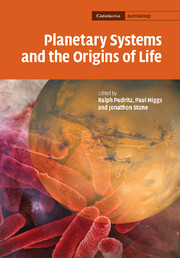Book contents
- Frontmatter
- Contents
- List of contributors
- Preface
- Part I Planetary systems and the origins of life
- Part II Life on Earth
- 6 Extremophiles: defining the envelope for the search for life in the universe
- 7 Hyperthermophilic life on Earth – and on Mars?
- 8 Phylogenomics: how far back in the past can we go?
- 9 Horizontal gene transfer, gene histories, and the root of the tree of life
- 10 Evolutionary innovation versus ecological incumbency
- 11 Gradual origin for the metazoans
- Part III Life in the Solar System?
- Index
9 - Horizontal gene transfer, gene histories, and the root of the tree of life
Published online by Cambridge University Press: 13 August 2009
- Frontmatter
- Contents
- List of contributors
- Preface
- Part I Planetary systems and the origins of life
- Part II Life on Earth
- 6 Extremophiles: defining the envelope for the search for life in the universe
- 7 Hyperthermophilic life on Earth – and on Mars?
- 8 Phylogenomics: how far back in the past can we go?
- 9 Horizontal gene transfer, gene histories, and the root of the tree of life
- 10 Evolutionary innovation versus ecological incumbency
- 11 Gradual origin for the metazoans
- Part III Life in the Solar System?
- Index
Summary
Introduction
Tracing organismal (species) histories on large evolutionary timescales remains a big challenge in evolutionary biology. Darwin metaphorically labelled these relationships the ‘tree of life’, but in his notebook he expressed unhappiness with this label, because in the ‘tree of life’ depicting species evolution only the tips of the branches are alive; this layer of living organisms rests on dead ancestors and extinct relatives. Darwin mused that therefore the term ‘coral of life’ would be more appropriate (B26 in Darwin (1987)); however, this alternative label did not gain popularity. Different markers have been utilized to elucidate the relationship among different lineages: from morphological characters to complete genomes. Since complete genomes are now available for organisms from all three domains of life, it is possible to use large amounts of data to attempt to decipher the relationships between all known organisms.
Many comparative genome analyses have shown that different genes in genomes often have different evolutionary histories (e.g., Hilario and Gogarten (1993), Nesbo et al. (2001), and Zhaxybayeva et al. (2004)), which implies that the tree of life metaphor (and a bifurcating tree as a model for evolutionary relationships in general) might be no longer adequate (Doolittle, 1999). The incongruence between gene histories can be attributed to many factors, one of which is horizontal gene transfer (HGT). Simulations based on coalescence have shown that HGT can affect not only the topology of an inferred phylogeny (and therefore inferences of last common ancestors), but also divergence times (Zhaxybayeva and Gogarten, 2004; Zhaxybayeva et al., 2005).
- Type
- Chapter
- Information
- Planetary Systems and the Origins of Life , pp. 178 - 192Publisher: Cambridge University PressPrint publication year: 2007
- 2
- Cited by



